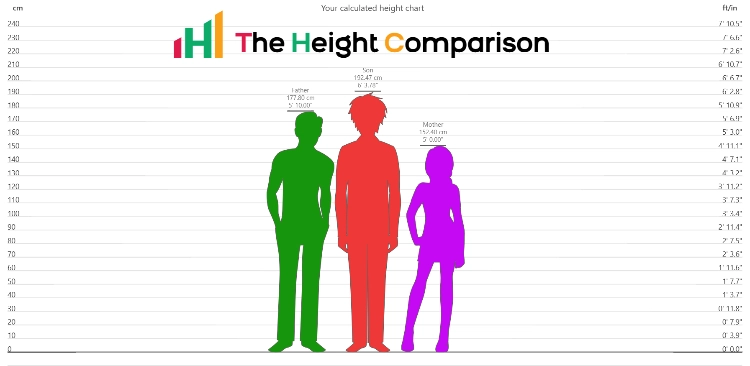Height Calculator: Predict Your Kid’s Future Growth
Child Height Predictor Awaits

Parents often wonder about their child’s potential height, and The Height Comparison (THC) introduces an innovative “Child Height Calculator” to provide insights into your child’s future stature. Let’s delve into the features, functions, and simple steps to use this powerful tool.
Child Height Predictor Tool
A Child Height Predictor is a valuable tool designed to estimate a child’s potential adult height, considering the parental heights. This specialized calculator employs mathematical models, often incorporating statistical regression analysis, to generate predictions about a child’s future stature.
Using the Child Height Calculator involves entering specific details into the calculator, such as the child’s age, current height, weight, and the heights of both parents. The tool then processes this information using its predictive algorithm, presenting results in numerical format, giving parents insights into their child’s potential growth trajectory.
Parents often turn to child height predictors for practical reasons, such as planning for future clothing sizes and making adjustments to accommodate their child’s expected height in the home environment. While these predictions offer valuable insights, it’s crucial to understand that they are based on statistical models and may not account for all factors influencing a child’s growth.
Understanding the Height Calculator
The Height Calculator on THC is specifically designed for predicting the future stature of children. It utilizes a sophisticated algorithm that takes into account factors like age, current height, weight, and the heights of both parents. This comprehensive approach ensures it is a 100 percent accurate height predictor, tailored to your child’s unique characteristics.
How to Use the Height Calculator
Using the Height Predictor is a breeze:
- Enter Child Information: Provide details such as age, current height, weight, and gender.
- Enter Parents Heights: Input the heights of both parents.
- Click Calculate: Hit the calculate button to see instant results.
The tool not only provides precise predictions but also generates a visual height chart. This chart offers a comparison between your child’s predicted height and the heights of both parents.
Features of THC’s Height Calculator
- Accurate Results: Our Height Calculator leverages advanced algorithms to ensure accuracy in predicting your child’s future height. So you can say that it is a 100 percent accurate height predictor.
- Visual Height Chart: Beyond numbers, the tool creates a visual representation, making it easier to comprehend and compare.
- Download and Share: You can download the height chart for future reference and share it on social media, involving friends and family in the excitement of predicting your child’s growth.
Height Calculator Uses
- Planning Clothing Sizes: Anticipate your child’s future clothing needs with insights into their potential adult height.
- Genetic Understanding: Deepen your understanding of the genetic factors contributing to your family’s stature.
- Home Environment: Consider your child’s estimated height when arranging furniture and planning living spaces.
- Educational Planning: Consider your child’s potential height when planning for educational needs.
- Sports and Activities: Gain foresight into potential interests influenced by your child’s height.
Different Terminologies Used for Height Calculator
Height Comparison Calculator
The Height Comparison Calculator stands out as a unique and practical tool, offering users the ability to compare and contrast heights effortlessly. This tool provides a new dimension to the exploration of height-related genetics and comparisons.
Children’s Height Calculator
Specifically catering to children aged 15 and below, the Children’s Height Calculator provides advanced estimations based on various factors. It is designed to offer insights into the potential adult stature of children.
Height Predictor Calculator
The Height Predictor Calculator is a cutting-edge tool designed to estimate a child’s future stature. It goes beyond mere estimation, providing a comprehensive analysis through visual aids such as height chart.
Child Height Calculator
The Child Height Calculator is a valuable resource for parents, offering a visual representation of a child’s growth potential through a height chart. It aids parents in understanding and preparing for their child’s future height.
Calculate Height in CMs
Calculating height in centimeters (cm) is a straightforward process that involves converting measurements from feet and inches or other units to the metric system. This conversion allows for flexibility in expressing and understanding height in different units.
Height Difference Calculator
The Height Difference Calculator serves as a fun and informative way to compare and contrast the physical dimensions of individuals, offering a unique perspective on the diversity of human stature. Whether for personal curiosity or casual comparisons, the Size Difference Predictor adds an engaging element to The Height Comparison’s suite of height-related tools.
Height Calculator for Boys
In parenting, understanding and monitoring the growth of boys is a crucial aspect. A reliable tool such as a size calculator tailored for boys becomes an invaluable companion. By utilizing this tool, parents can anticipate not only the potential height of their boys but also gain valuable insights into the genetic factors influencing their growth.
It’s a user-friendly and efficient way for parents to stay actively involved in their boys’ development, offering a visual representation of the growth trajectory through intuitive height charts. This tool empowers parents to make informed decisions about their boys’ nutrition, lifestyle, and overall well-being, ensuring they embark on a healthy and confident path to adulthood.
Height Chart Calculator
A height chart calculator is a valuable tool that assists in estimating and visualizing an individual’s growth over time. It typically considers factors such as age, gender, current height, and parental heights to predict potential adult height.
Height Prediction Calculator
Parents often use height prediction calculators to gain insights into their child’s potential growth. It helps them plan for clothing sizes, furniture arrangements, and other aspects of parenting. Individuals under 15 years curious about their own future size may also find height predictors intriguing.
Conclusion
The Height Calculator for Kids on THC is more than just a tool; it’s a gateway to understanding and preparing for your child’s growth journey. Unlock the potential of your child’s future height with precision and confidence.
FAQs:
Are there specific height predictors for different age groups?
While some height calculators cater to specific age groups, many are designed for children and adolescents. Ensure you choose a predictor that aligns with your child’s age for optimal accuracy like THC’s Height Calculator.
Can a child's diet impact the accuracy of height predictions?
Nutrition plays a crucial role in growth. A balanced diet contributes to healthy development, potentially influencing the accuracy of height predictions provided by the calculator.
Do height predictors work for children with special health conditions?
Height predictors are generally designed for typical growth scenarios. For children with unique health conditions, consulting a healthcare professional is recommended for personalized assessments.
How do height predictors differ from traditional growth charts used by doctors?
Traditional growth charts used by doctors are based on population averages. Height predictors, on the other hand, often incorporate parental data for a more individualized prediction.
Can I use a height predictor if my child's growth has been irregular?
While irregular growth patterns can pose challenges, height predictors can still provide valuable estimates. However, it’s crucial to consider consulting a healthcare professional for a comprehensive assessment.
Related Article:
Height Comparison Chart – Compare Heights Like Never Before
Quick Height Calculator: Unleashing the Art of Height Prediction
Height and Sports: Does Size Really Matter?
Related Useful Tools:





